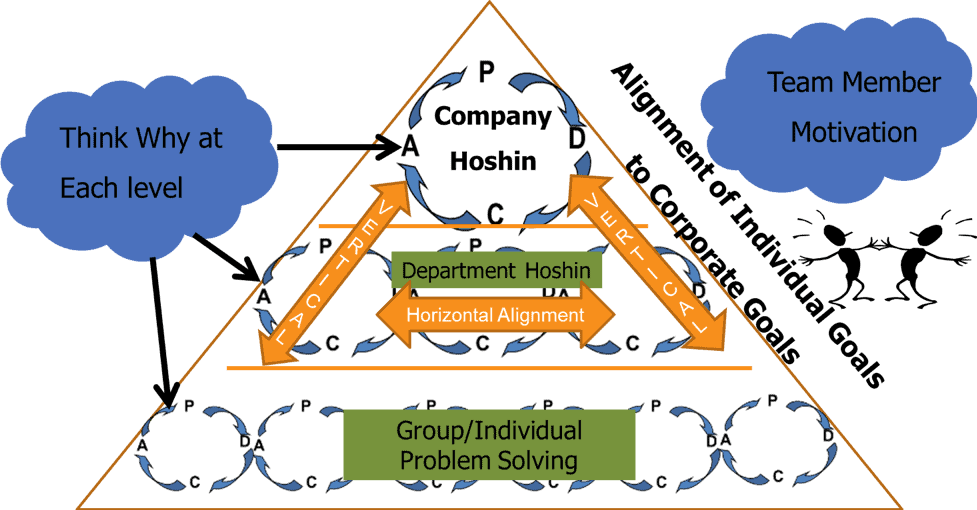How well do you think Hoshin Kanri Planning is effective in modern business? Strategic planning is evolving every day to adapt to the ever-changing world but the primary goals are to eliminate waste, improve quality, and increase customer value. And what are the goals that Hoshin Kanri planning is aimed at?
Hoshin Kanri Planning used to be not so popular in the past but many experts claim that this strategic planning tool is a trend that is gaining popularity and effectiveness in the current business environment, where change is rapid and complex. And now it is high time to bring it back and make the most out of it.
| When was Hoshin Kanri Planning first introduced? | 1965 in Japan |
| Who founded Hoshin Kanri? | Dr Yoji Akao |
| What is Hoshin planning also known as? | Policy deployment |
| What companies use Hoshin Kanri? | Toyota, HP, and Xerox |
Table of Contents
- What is Hoshin Kanri Planning?
- Implement Hoshin Kanri X Matrix
- Advantages of Hoshin Kanri Planning
- Disadvantages of Hoshin Kanri Planning
- How to use the Hoshin Kanri method for strategic planning?
- Key Takeaways
- Frequently Asked Questions
What is Hoshin Kanri Planning?
Hoshin Kanri Planning is a strategic planning tool that helps organizations align company-wide objectives to the day-to-day work of individual contributors across different levels. In Japanese, the word “hoshin” means “policy” or “direction” while the word “kanri” means “management.” So, the whole words can be understood like "How are we going to manage our direction?”
This method originated from lean management, which pushes all employees to work toward the same goals, with the aim of cost-effectiveness, quality enhancement, and customer-centricity.

Implement Hoshin Kanri X Matrix
When mentioning Hoshin Kanri Planning, its best process planning method is visually represented in the Hoshin Kanri X Matrix. The matrix is used to determine who is working on what initiative, how strategies connect to initiatives, and how they map back to long-term goals. Here is how it works:

- South: Long-Term Goals: The first step is to define the long-term goals. What is the overall direction you want to move your company (department)?
- West: Annual Objectives: Out of the long-term objectives, the annual objectives are developed. What do you want to achieve this year? In the matrix between the long-term goals and the annual objectives, you mark which long-term goal is aligned with which annual goal.
- North: Top-Level Priorities: Next, you develop the different activities you want to do to achieve the annual results. In the matrix in the corner, you again connect the previous annual objectives with the different priorities to achieve these objectives.
- East: Targets to Improve: Based on the top-level priorities, you create (numeric) targets to achieve this year. Again, in the field between the top-level priorities and the targets, you mark which priority influences which target.
However, some critics argue that while the X-Matrix is visually impressive, it may distract the user from actually following the PDCA (Plan-Do-Check-Act), especially the Check and Act parts. Therefore, it’s important to use it as a guide, but not lose sight of the overall goals and the process of continuous improvement.

Advantages of Hoshin Kanri Planning
Here are five benefits of utilizing Hoshin Kanri planning:
- Establish your organization’s vision and make it clear what that vision is
- Lead organizations to focus on a few important strategic initiatives, rather than spreading resources too thin.
- Empower employees across all levels and increase their sense of ownership towards the business because everyone has the same chance to participate and contribute towards the same end.
- Maximize achieve alignment, focus, buy-in, continuous improvement, and speed in their effort to target their objectives.
- Systematize strategic planning and provide a structured and unified approach: what needs to be achieved and how to achieve it.
Disadvantages of Hoshin Kanri Planning
Let's come to the five challenges of using this strategic planning tool that businesses are facing nowadays:
- If the goals and projects within an organization are not aligned, the Hoshin process may falter.
- The seven steps of Hoshin do not include a situational assessment, which can lead to a lack of understanding of the current state of the organization.
- Hoshin Kanri planning method cannot overcome fear within an organization. This fear can be a barrier to open communication and effective implementation.
- Implementing Hoshin Kanri does not guarantee success. It requires commitment, understanding, and effective execution.
- While Hoshin Kanri can help align goals and improve communication, it does not automatically create a culture of success within the organization.
When you want to ultimately bridge the gap between strategy and execution, there is no better way to implement the Hoshin 7-step process. The structure is fully described as follows:

Step 1: Establish the Vision and Values of the Organization
The first and foremost step is to visualize the future state of an organization, it can be inspirational or aspirational, hard enough to challenge and inspire the employees to show high job performance. This is typically done at the executive level and focuses on identifying the current state of the organization concerning your vision, planning process, and execution tactics.
For example, AhaSlides aims to be the leading platform for interactive and collaboration presentation tools, its vision and mission cover innovation, user-friendliness, and continuous improvements.
Step 2: Develop Breakthrough 3-5 years Objectives (BTO)
In the second step, the business sets up must-completed time frame objectives within 3 to 5 years, for example, acquiring a new line of business, disrupting markets, and developing new products. This time frame is usually the golden period for businesses to break through the market.
For example, A breakthrough objective for Forbes could be to increase its digital readership by 50% over the next 5 years. This would require significant changes in their content strategy, marketing, and perhaps even their website design.
Step 3: Develop Annual Goals
This step aims to set up annual goals means decomposing business BTO into goals that will need to be achieved by the end of the year. The business must stay on course to ultimately build shareholder value and meet quarterly expectations.
Take Toyota’s annual goals as are example. They could include increasing hybrid car sales by 20%, reducing production costs by 10%, and improving customer satisfaction scores. These goals would be directly linked to their breakthrough objectives and vision.
Step 4: Deploy Annual Goals
This fourth step in the 7-step Hanshin planning method refers to taking action. Different strategic tactics are executed to track the progress on a weekly, monthly, and quarterly basis to ensure small improvements that lead to annual goals. Middle management or front-line is responsible for daily administration.
For example, to deploy its annual goals, AhaSlides has transformed its team regarding task-assigning. The development team made a lot of effort to introduce new features every year, while the marketing team could focus on expanding into new markets through SEO techniques.
Step 5: Implement Annual Objectives (Hoshins / Programs / Initiatives / AIPs etc…)
For operational excellence leaders, it is vital to target the annual objectives regarding daily management discipline. At this level of the Hoshin Kanri planning process, mid-level management teams plan carefully and in detail the tactics.
For instance, Xerox might launch a new marketing campaign to promote their latest line of eco-friendly printers. They could also invest in research and development to improve the efficiency and sustainability of their products.
Step 6: Monthly Performance Review
After defining objectives at the corporate level and cascading through the management level, businesses implement monthly reviews to continuously track progress and monitor outcomes. Leadership is significant in this step. It is suggested to manage a shared agenda or action items for one-on-one meetings every month.
For instance, Toyota would likely have a robust system for monthly performance reviews. They might track key performance indicators (KPIs) like the number of cars sold, production costs, and customer feedback scores.
Step 7: Annual Performance Review
At the end of each year, it is time to have a reflection on the Hoshin Kanri plan. It is a kind of annual "check-up" to ensure the company is in healthy development. It is also the best occasion for businesses to set the following year's goals, and restart the Hoshin planning process.
At the end of the year 2023, IBM will review its performance against its annual goals. They might find that they exceeded their targets in some areas, such as cloud computing services, but fell short in others, like hardware sales. This review would then inform their planning for the next year, allowing them to adjust their strategies and objectives as needed.
Key Takeaways
Effective Strategic planning often goes with employee training. Leveraging AhaSlides to make your monthly and annual staff training more engaging and compelling. This is a dynamic presentation tool with a quiz maker, poll creator, word cloud, spinner wheel, and more. Get your presentation and training program done in 5 minutes with AhaSlides now!
Frequently Asked Questions
What are the 4 Phases of Hoshin Planning?
The four phases of Honshin planning include: (1) Strategic Planning; (2) Tactical Development, (3) Taking Action, and (4) Reviewing to Adjust.
What is Hoshin planning technique?
Hosin planning method is also known as Policy management, with a 7-step process. It is used in strategic planning in which strategic goals are communicated throughout the company and then put into action.
Is Hoshin Kanri a lean tool?
Yes, it follows the lean management principle, where inefficiencies (from the lack of communication and direction among different departments within a company) are removed, leading to better quality of work and improving customer experience.
Ref: allaboutlean | leanscape








